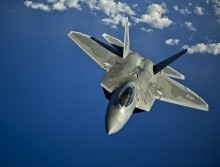
US jets have hit ISIS for nearly a year—but who is winning? US F-22 jet. Illustrative. Photo Courtesy of U.S. Air Force photo/Tech. Sgt. Michael Holzworth.
ISIS has managed to replace the number of operatives killed in the fight with the US-led coalition according to USA Today, but a US military official is pointing to other factors in arguing the fight is succeeding in beating back the terror group. The USA Today report cited a military intelligence official as saying that ISIS (also known as ISIL) still is estimated to have the same number of operatives in Iraq and Syria as they did last year, believed to be between 20,000 and 31,500. This despite the coalition killing 15,000 ISIS fighters in almost one full year of airstrikes.
However, the article did say military estimates believe the campaign has cut down on ISIS’ ability to take large areas of territory, which is part of ISIS’ goal of building a new Islamic empire. ISIS gains in Iraq and Syria were a key motivator for starting the coalition airstrike campaign, and a US military official believes the effort is working.
“This is not the same fight as it was when it started, and I look at that based on the effects that we have had on ISIL,” US Brigadier General Kevin J. Killea, chief of staff for the US mission against ISIS, told reporters on Friday in comments posted to the Department of Defense website.
Killea said forces fighting ISIS had taken over 5,300 square kilometers—or more than 2,000 square miles—from ISIS in Syria since May. He did admit the numbers change regularly in the fight. Still, he believes the more than 5,600 airstrikes on ISIS and the overall campaign is changing ISIS’ approach to the war.
“They are much more territorial, meaning they’re defending more than they’re on the offensive,” said Killea. “Their attacks are smaller, they are more focused, and they’re less enduring, and all you have to do is look at the gains that have been made on the ground recently to see that there is an effect, and there is progress.”
(By Joshua Spurlock, www.themideastupdate.com, August 2, 2015)
